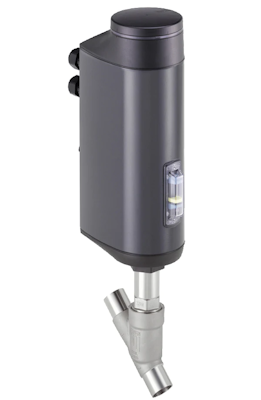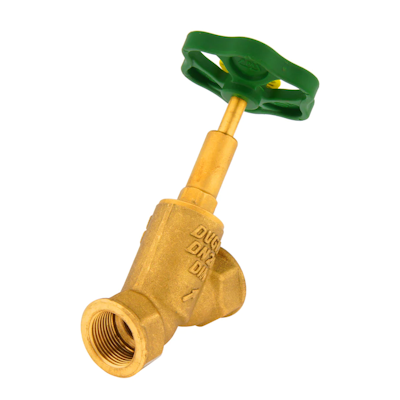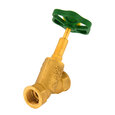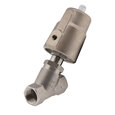Angle Seat Valve Actuation
Figure 1: Angle seat valve with pressure gauge
There are various actuation options for angle seat valves: pneumatic, electric, and manual. Each type enhances system performance differently; for example, pneumatic actuation ensures quick response and durability, electric actuation provides precise control and easy automation integration, and manual actuation offers simplicity and cost-effectiveness. This article examines the design and operational advantages of each actuation method.
View our angle seat valve selection here!

Angle seat valve working principle
In an angle seat valve, the valve seat is positioned at an angle of 45 degrees relative to the flow path. This enhances fluid flow efficiency by allowing a smoother transition of media through the valve, which can reduce pressure drop and energy consumption. An actuating force (pneumatic, electric, or manual) is applied to the control piston to lift/close the seat gasket, allowing fluid flow. Pneumatic actuation uses compressed air to move a control piston, electric actuation employs a motor to generate movement, and manual actuation relies on a hand-operated lever or wheel to manipulate the valve. Read our angle seat valve overview article for more information on the design and working of the valve.
Pneumatically actuated angle seat valve
Figure 2: Stainless steel pneumatic angle seat valve
Pneumatically actuated angle seat valves use compressed air to move the valve piston, allowing for quick opening and closing actions. The angled seat design ensures high flow rates and effective operation.
Pneumatic actuators can be single-acting or double-acting:
- Single-acting (spring return) actuators typically use a 3/2 valve with three ports and two positions. One position supplies air to the actuator to move it in one direction (e.g., open the valve), and the spring returns the actuator to its original position (e.g., closes the valve) when the air supply is cut off.
- Double-acting actuators require air to move in both directions (open and close). They typically use a 4/2 or 5/2 valve to control the air supply. These valves have more ports and positions to direct air flow appropriately to open or close the actuator.
Single-acting actuators with a 3/2 valve are often chosen for applications where a fail-safe position is needed, while double-acting actuators might be selected for applications requiring more precise control over the valve position or where no default fail-safe position is required. Read our Burkert 2000 angle seat valve article for more details on the features of these pneumatic angle seat valves.
Main features
- Fast actuation: Quick response times for timely control.
- High force: Suitable for large valves or high-pressure applications.
- Self-draining: Ideal for sanitary applications, preventing fluid retention.
- Steam compatibility: Can handle high temperatures and pressures and excellent for steam control applications
Disadvantages
- Compressed air requirement: Increases operational complexity and costs.
- Actuator size: May not fit in limited spaces.
- Noise levels: Can be loud, potentially requiring additional noise control measures.
Applications
- Steam control: For sterilization and heating in various industries.
- Water treatment: Managing flow in filtration and chemical dosing.
- Food and beverage industry: In sterile processing and filling operations.
Electrically actuated angle seat valves

Figure 4: Electric stainless steel angle seat valve
Electrically actuated angle seat valves are operated by electric motors. When an electrical signal is sent to the actuator, it moves the piston, which in turn changes the position of the valve seat. This movement allows the valve to either block or allow flow through the valve body. Electrical actuation is well-suited for integration into automated systems.
Main features
- Precision control: Allows for accurate flow adjustments.
- Remote operation: Can be easily integrated into digital control systems.
- Proportional control: Adjusts valve opening in relation to an electrical signal.
Disadvantages
- Control precision: May offer more precision than needed in simple on/off applications, potentially increasing costs.
- Energy dependency: Relies on a continuous power supply.
Applications
- Brewing and beverage production: For consistent quality control during processing.
- Water treatment plants: Automates flow for efficiency and reliability.
- Pharmaceutical manufacturing: Ensures sterility with precise steam and water flow control.
Manual angle seat valves

Figure 3: Manual brass angle seat valve
Manual angle seat valves are operated by hand, using a handwheel or lever to adjust the valve's position. This direct control method is simple and reliable, suitable for applications where automation is not necessary.
Main features
- Direct control: The operator can easily adjust flow rates and positions.
- Simplicity: No need for external power sources or complex control systems.
Disadvantages
- Manual operation: Not suitable for high-pressure applications or large valves that require significant force to operate.
- Limited application: May not be ideal for processes requiring quick or frequent adjustments.
Applications
Manual angle seat valves are typically used in remote locations where power supply and automated control are not feasible and in systems where automation is not required. For example:
- Chemical and pharmaceutical industries: For precise control of aggressive chemicals and solvents during dosing, filling, and mixing processes.
- Steam control in heating systems: To regulate steam flow in heat exchangers, autoclaves, and industrial cleaning equipment, ensuring efficient and safe operation.
While manual valves are common in the mentioned applications, some facilities might utilize automated processes with fail-safe manual overrides for critical operations; however manual valves provide reliable backup or control for simpler tasks.
Read our angle angle seat valve selection article for more information on the key selection parameters while choosing an angle seat valve for an application.
Comparison
Choosing between pneumatic, electric, and manual angle seat valves involves considering several key factors specific to the application's requirements as seen in Table 1.
Table 1: Pneumatic, electric, and manual angle seat valve comparison
| Factor | Pneumatic | Electric | Manual |
| Power source availability | Ideal to use when there is reliable compressed air supply. Preferred in explosive environments due to no ignition risk | Best choice if electricity is readily available and precise control is needed. Suitable where compressed air is impractical. | Optimal where neither electricity nor compressed air is available. Ideal for direct control without automation |
| Control and automation needs | Suitable for automated processes requiring remote control | Offers finer control over valve positioning, ideal for integration into automated control systems | Best for applications where manual control is sufficient, especially for simple on/off operations |
| Environmental Conditions | Performs well in harsh conditions (wet, dusty, explosive) due to lack of electrical components | Suitable for clean environments. Consider IP rating for dust and water protection in challenging conditions | Good for a wide range of environments. Less affected by conditions due to non reliance on power sources or control systems |
| Response time and precision | Rapid response times, suitable for quick actuation needs. | Provides precise control, ideal for careful regulation of flow rate or pressure. | Depends on the operator. Suitable where valve actuation timing is not critical. |
| Cost | May require additional infrastructure for compressed air, but generally less expensive than electric valves | More expensive upfront due to precision control mechanisms but can save on operating costs where compressed air is not available | Most cost-effective in terms of initial investment and maintenance |
| Maintenance and lifespan | Requires regular maintenance of the air supply system to prevent contamination. | Requires less maintenance than pneumatic systems | Requires the least maintenance; however, operator accessibility must be ensured |







